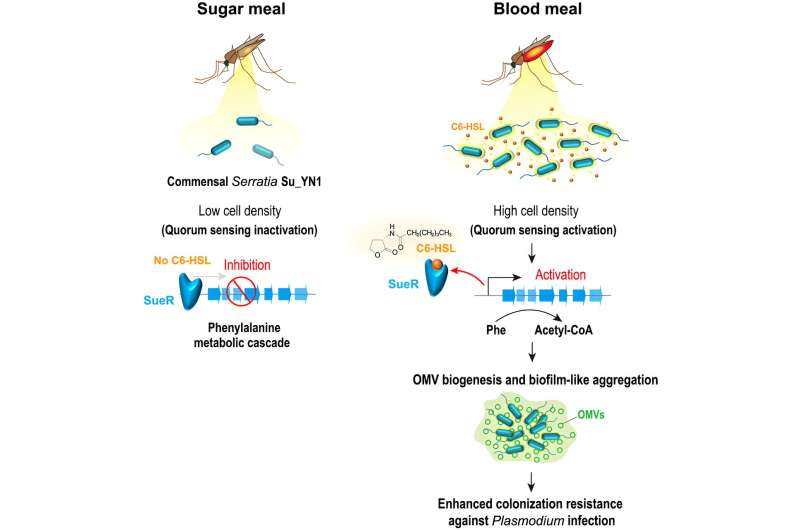This article has been reviewed according to Science X's editorial process and policies. Editors have highlighted the following attributes while ensuring the content's credibility:
fact-checked
peer-reviewed publication
trusted source
proofread
Quorum sensing circuit controls mosquito commensal gut colonization via OMV-mediated aggregation

Prof. Wang Sibao from Center for Excellence in Molecular Plant Sciences of the Chinese Academy of Sciences and his colleagues have revealed that quorum sensing-activated phenylalanine metabolism drives outer membrane vesicles (OMVs) biogenesis to enhance commensal colonization resistance to Plasmodium in the mosquito gut. The study was published online in Cell Host & Microbe.
The gut microbiota has co-evolved with its host in a symbiotic relationship and plays a crucial role in maintaining host health and preventing disease. The regulation of gut microbiota homeostasis has mainly been studied from the perspective of host immune regulation. The mechanism by which the microbiota regulates its adaptation and colonization remains unknown.
Mosquitoes depend on blood ingestion for propagation, while blood digestion induces hyper-oxidative stress on gut microbiota. The researchers discovered that commensal Serratia bacteria form biofilm-like aggregates in the midgut of blood-fed mosquitoes, suggesting that high-order aggregation facilitates commensal colonization of the gut. They found that these bacterial aggregates are highly ordered and driven by OMVs.
OMV biogenesis is controlled by an acyl-homoserine lactones (AHL) type quorum sensing (QS) circuit composed of a QS synthetase SueI and a QS receptor SueR. Using mass spectrometry, the researchers identified that SueI synthesizes the N-hexanoyl-L-homoserine lactone (C6-HSL) QS signal molecule, which stimulates OMV biogenesis and promotes commensal gut colonization.
Using comparative transcriptional analysis, they found that both C6-HSL treatment and SueR deletion lead to the same metabolic signaling remodeling pattern involving the activation of a critical phenylalanine cassette.
They also found that SueR binds to the promoter of the phenylalanine cassette to suppress its activation, while C6-HSL binding to SueR relieves this repression, leading to the activation of the phenylalanine cassette. This phenylalanine cassette is responsible for the conversion of phenylalanine to Acetyl-CoA and ATP, which serve as driving force for robust OMV biogenesis.
These findings showed that QS triggers the activation of phenylalanine metabolism to drive the biogenesis of Serratia OMVs in the gut. These OMVs contribute to the formation of bacterial aggregates and facilitate gut colonization.
Malaria remains one of the deadliest infectious diseases worldwide. A promising strategy for blocking the transmission of malaria is to populate mosquitoes with anti-Plasmodium bacteria, known as paratransgenesis or symbiont-based transmission blocking strategy.
The successful deployment of this strategy relies on effective colonization of anti-pathogen bacteria in the mosquito gut in high numbers. Therefore, it is important to find ways to promote effective adaptation of the anti-pathogen bacteria to the harsh gut environment of blood-fed mosquitoes.
This study demonstrated that exposing mosquito to C6-HSL, an environmentally-friendly molecule, promotes gut colonization of the Plasmodium-blocking Serratia bacterium while enhancing its Plasmodium transmission-blocking efficacy. It was suggested that QS molecules may be considered for use on bed nets or for indoor residual spraying to enhance the anti-parasitic gut bacteria colonization of mosquitoes, offering a new avenue for improving symbiont-based vector-borne disease control strategies.
This study revealed a crucial role played by quorum sensing-activated phenylalanine metabolism in OMV biogenesis and commensal gut colonization, and identified a promising strategy for enhancing mosquito commensal resistance to pathogens by applying QS signal molecules to female mosquitoes.
More information: Yongmao Jiang et al, Quorum sensing-activated phenylalanine metabolism drives OMV biogenesis to enhance mosquito commensal colonization resistance to Plasmodium, Cell Host & Microbe (2023). DOI: 10.1016/j.chom.2023.08.017
Journal information: Cell Host & Microbe
Provided by Chinese Academy of Sciences




















